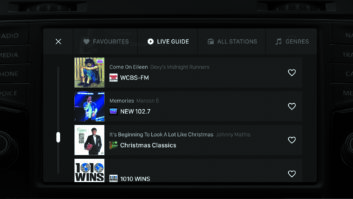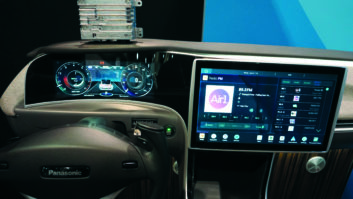The Los Angeles Auto Show in November had its share of product introductions and networking, but a related event immediately prior was the first AutoMobility LA, a mashup of the convention’s former Press & Trade Days with what used to be called Connected Car Expo, all aimed at people interested in the “new mobility.”

Of interest to radio broadcasters, DTS, parent company of HD Radio, presented information about Connected Radio, its hybrid radio project, to an audience of automotive journalists and industry analysts. DTS subsequently demonstrated Connected Radio in its booth at CES in January.
Jeff Jury, general manager for automotive and HD Radio for DTS, said the hybrid radio project is “the connection of over-the-air broadcast radio — analog, HD or, in other areas like Europe, DAB — with internet-delivered content.” The system includes NextRadio in North America and will incorporate RadioDNS capability for regions where that is used. The goal of hybrid radio systems, Jury said, is to offer more content to the user and provide, in his words, a more compelling overall radio experience.
“We believe the value of the system is that the majority of the content comes over the air,” said Jury. “We’re not talking about another way of doing streaming. This does not drain someone’s [smartphone] data plan, if you do it that way, and it takes advantage of the great ability of radio to deliver one-to-many content.”
In September, DTSVice President of Technology Solutions Ray Sokola said in a Radio World interview that hybrid radio “expands the listening experience to take advantage of the best of the past, present and future capabilities that cellular connectivity, the internet, streaming and apps have added to the traditional radio experience.” He said implementations start with adding album art and easy purchase capability to a radio experience, but “it goes way beyond that and is only limited by our imagination.”


GLOBAL PRODUCT
DTS remains committed to rolling out HD Radio across North America, Jury told Radio World. “In addition, Connected Radio gives us a more global platform for car companies. It is not tied exclusively to HD Radio platforms, and we will be incorporating it with DAB radio systems where DAB in prevalent.
“When you talk to car companies, what they really want is a global product. Not everyone around the world has streaming available to them. If you are building a global product, it has to work in North America, South America, Europe and Asia; radio is a common element of that.”
The system as envisioned by DTS would work with existing telematics platforms like the Toyota Entune and GM OnStar and be part of the choices a user would see when the platform opens.
Jury believes hybrid radio technology may hit the center stacks of cars within a couple of years.
“We are working with a number of the [car companies] today; they have versions of our software, and I don’t envision any problems with the software getting in there. The real question is how you build it out on a global basis.”
Jury also spoke about DTS’ effort to improve in-vehicle reception of radio.
“Sometimes people think we’re just looking at improving HD Radio; we spend a lot of time improving radio reception in the car by working with the car companies on antenna placement, algorithms that can improve the reception; it’s something we take very seriously to make [listening] the best possible experience out there.” Those efforts have included convincing one unnamed manufacturer not to place an antenna in the vehicle bumper.

Ford’s 2018 EcoSport is a global product introduced to the American market at the LA Auto Show. Its chief program engineer, Eric Loefler, says attention to antenna placement was important when integration decisions with the third generation of Ford’s SYNC infotainment system and the 675-watt, 10-speaker B+O Play sound system were being made. “We have a dual antenna system, where we have a mast on the back of the vehicle [like a shark fin] for reception, and we also have a redundant diversity antenna that’s basically in the backlight [rear window] of the vehicle.”
Jury believes manufacturers may be more inclined to include radio listening options as a primary menu choice as hybrid radio is developed and fielded. He says radio broadcasters should be asking how to preserve their position in the center stack and how to remain pre-eminent in the center of the vehicle.
“You don’t want a situation with the cars of today where you have to go down five or six menus to find radio; you want radio to be there as soon as you turn on the vehicle.”











